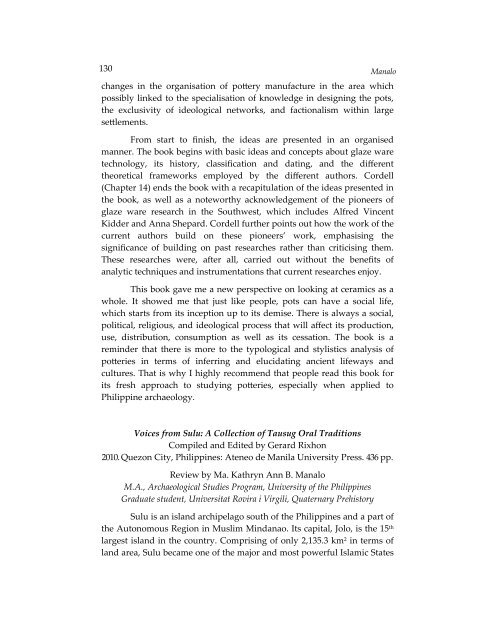You also want an ePaper? Increase the reach of your titles
YUMPU automatically turns print PDFs into web optimized ePapers that Google loves.
130Manalochanges in the organisation of pottery manufacture in the area whichpossibly linked to the specialisation of knowledge in designing the pots,the exclusivity of ideological networks, and factionalism within largesettlements.From start to finish, the ideas are presented in an organisedmanner. The book begins with basic ideas and concepts about glaze waretechnology, its history, classification and dating, and the differenttheoretical frameworks employed by the different authors. Cordell(Chapter 14) ends the book with a recapitulation of the ideas presented inthe book, as well as a noteworthy acknowledgement of the pioneers ofglaze ware research in the Southwest, which includes Alfred VincentKidder and Anna Shepard. Cordell further points out how the work of thecurrent authors build on these pioneers’ work, emphasising thesignificance of building on past researches rather than criticising them.These researches were, after all, carried out without the benefits ofanalytic techniques and instrumentations that current researches enjoy.This book gave me a new perspective on looking at ceramics as awhole. It showed me that just like people, pots can have a social life,which starts from its inception up to its demise. There is always a social,political, religious, and ideological process that will affect its production,use, distribution, consumption as well as its cessation. The book is areminder that there is more to the typological and stylistics analysis ofpotteries in terms of inferring and elucidating ancient lifeways andcultures. That is why I highly recommend that people read this book forits fresh approach to studying potteries, especially when applied toPhilippine archaeology.Voices from Sulu: A Collection of Tausug Oral TraditionsCompiled and Edited by Gerard Rixhon2010. Quezon City, Philippines: Ateneo de Manila University Press. 436 pp.Review by Ma. Kathryn Ann B. ManaloM.A., Archaeological Studies Program, University of the PhilippinesGraduate student, Universitat Rovira i Virgili, Quaternary PrehistorySulu is an island archipelago south of the Philippines and a part ofthe Autonomous Region in Muslim Mindanao. Its capital, Jolo, is the 15 thlargest island in the country. Comprising of only 2,135.3 km 2 in terms ofland area, Sulu became one of the major and most powerful Islamic States



